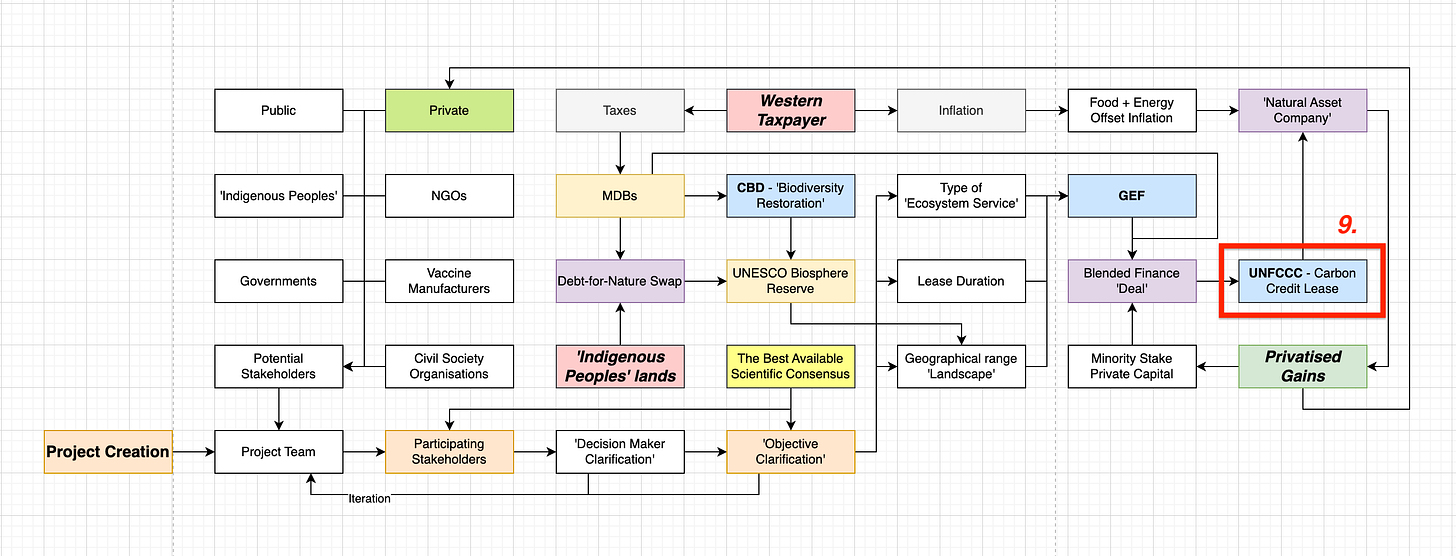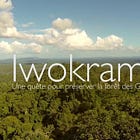It’s the biggest scam ever devised, and will empty the public coffers and drain the middle class of the West, while stealing prime lands in third world nations.
Let’s run through how it works.
The entire scheme can be approximated using the below flowchart. Sure, detail is missing in some regards, like the creation of the (politically expedient) ‘best available scientific consensus’ which typically comes courtesy of Universities and NGOs, both of which generally receive generous ‘research grants’ courtesy of 'philanthropes’ representing the ‘private investor’ which you can however find in the below. I highlight specifically this one, as it’s probably the most important link left out.
But the point here is to put the dynamic in simple terms, and consequently, some nodes will have to go. Feel free comment below if you think I omitted some of pivotal importance.
But time is of essence, so let’s get on with the show.
-
Step 1 - Project Creation
Doesn’t really matter what said project is, but let’s say it’s claimed restoration of mangroves in Suriname, on a geographical range (‘landscape’) where some unfortunate native South American tribe has lived for many generation.
Step 2 - Assembling the Project Team
The Project Team is responsible for locating the ‘participating stakeholders’, as well as settling on the scope of the project itself, and its management structure. Said stakeholders could comprise a selection of NGOs, governments, representatives of the public, private… or even ‘indigenous peoples’, should the budget allow (no, really).
Step 3 - Locate the initial set of ‘stakeholders’.
It doesn’t matter too much at this stage if any are ‘bad fits’ (ie, disagees with the project direction), but the first set of ‘stakeholders’ is assembled, after several rounds of interviews and submitted forms, allowing said project team to discard those least likely to ‘fit in’.
Step 4 - Clarify who the decision makers are.
In short, the project team here can decide that all the ‘participating stakeholders’ are merely there in advisory capacity. But should any at this stage cause a problem, hey, now’s a great time to ‘iterate’ said, which in short means replace them with others who are more compliant. Because ‘agreeement’ is very, very important when it comes to these projects.
Step 5 - Objective clarification.
At this stage, the project details are discussed and clarified - ie, which geographic range is of interest, the duration of the project, and exactly what to ‘restore’.
At this stage, if further ‘participating stakeholders’ disagree, these can then be ‘iterated’, ensuring everyone is ‘in agreement’. And finally, should the best available scientific consensus disagree, the project team can wholesale override all ‘participating stakeholder’ input and just adopt that as policy.
And naturally, the management should be ‘adaptive’, meaning regardless of scale of disaster, or random changes halfway through the project - hey, they were simply following the ‘best available science’, and consequently, no further action needs taking, and certainly no legal action.
Step 6 - Project Details
With all ‘participating stakeholders’ in ‘agreement’ (as all those in disagreement were ‘iterated’ out) three primary decisions are reached. Which geographic range must be ‘restored’ (ie, the ‘landscape’), the duration of the project, and which type of ‘ecosystem service’ is of interest. In our case, the ‘landscape’ - or ‘seascape’ - is a patch of land/sea with mangroves in Suriname, the ‘ecosystem service’ of interest is carbon credits, and lease duration - let’s put that at 10 years.
Step 7 - The Blended Finance Deal.
These three input parameters are then handed to the Global Environment Facility, who will structure a ‘blended finance deal’, and go to find investors.
Step 8 - The Blended Finance Investors.
With said deal structured, we need investors. We shall ignore claims of all others but two (including ‘philanthropic capital’) because in the grand scheme of things, those are utterly irrelevant.
Blended finance is titled as such because it draws in different types of investors, representing ‘different expectations’. In short, the private minority investor, and the much larger public investor (generally, the Multilateral Development Banks, funded through public taxation).
And while the public shoulders the vast, vast majority of risk, the private receives a far more generous return. These ‘deals’ are incredibly one-sided affairs.
Step 9 - The Lease
At this stage, we have a carbon credit lease for mangroves in Suriname, with a 10-year duration. What this essentially means is that all the carbon dioxide sucked out of the air by those mangroves in Suriname (or could equally be ie forests in Indonesia or Siberia; in short, ‘carbon sinks’ per the 1992 UNFCCC framework treaty) have been turned into carbon emission permits, because the flip side of the carbon coin is called a source, and these require netting.
Net Zero, so to speak.
Step 10 - The Natural Asset Company.
In order to extract maximum value from these carbon emission permits, the lease is placed into a holding company of type Natural Asset Company, and floated on the stock exchange. And as these permits soon will be in short supply (as supply is gradually curtailed per Paris Agreement as we close in on 2030), their price will almost certainly rapidly increase vastly.
And, sure, while NACs were delivered a temporary setback, they will be pushed again and again until they pass. It’s just a matter of locating the right distraction. Or stock exchange, even.
Step 11 - Offsetting.
The 1992 UNFCCC Framework Treaty not only made mention of ‘carbon sinks’, but also emitting ‘carbon sources’, like farming or energy (electricity generation, car emissions, …). The concept of ‘offsetting’ relates to whatever a ‘carbon source’ is alleged to emit, this requires netting out with a ‘carbon sink’.
And that means a farmer - or oil producer - now will be required to buy large quantities of ‘carbon emission permits’ from those Natural Asset Companies - yes, those, now vastly increased in price.
Step 12 - Inflation.
With farmers, energy producers, and transportation experiening vast increases in input prices, they have no option but to push this onto the consumer, through cost-push inflation. And this leads to higher prices in the supermarkets, and more expensive fuel and heating.
Step 13 - The (largely) Western Taxpayer.
And the people represented by governments, fully signed up for this scheme, will now feel the full brunt of said inflation. The West will be hit, full-force.
Step 14 - Taxes.
Incidentally, it’s not the only direction from which the West will be hit. Recall those MDBs in step 8 above? Yes, their funding will also come, courtesy of said Western taxpayer. Taxes will increase, and subsidies will be reallocated, leading to even further price increases as the plan very much is to strip ‘harmful’ subsidies from farming and energy.
Step 15 - The Biodiversity Restoration.
Now, the GEF project outlined in step 7, using the ‘landscape’ outlined in step 6 (mangroves in Suriname), these require ‘restoration’, and this is where the Convention on Biological Diversity rears its ugly head. And said ‘biodiversity restoration’ will also be paid for using MDB funds, ie, Western taxes.
Step 16 - The UNESCO Biosphere Reserve.
The ‘restored’ ‘landscape’ itself will typically be located on either a ‘Biosphere Reserve’, or a ‘Heritage Site’, both of which are UNESCO projects. But from where do said sites originate? Who submits these, and why?
Step 17 - The Debt-for-Nature Swap.
Well, those reserves typically come courtesy of highly indebted third world nations, or should said not be, the aim is to have territorial rights handed over to ‘indigenous peoples’, who then will be pressured or bribed into accepting a such swap.
The objective with the swap is to eventually cause a debt spiral, eventually leading to circumstances of the exploitation rights of said lands being fully handed over to said UNESCO Biosphere Reserves. And those swaps, of course, are also financed courtesy of those MDBs, and ultimately, the Western taxpayer.
Step 18 - The Reward.
While some rewards will be handed back to the MDBs through those blended finance deals, the simple fact is that the associated risk easily outweighs the gain.
Consequently, the gain is actually privatised, and some of said can then be used to finance further GEF blended finance deals. But most will make it back to…
Step 19 - The Private Investor.
Said gain will actually filter back to the private investor, who may or may not be selected as a stakeholder for the project in the first place. Hey, he might even be on the project team, or even fabricate the latest and greatest politically expedient ‘best available scientific consensus’.
Step 20 - The Net Result.
Consequently, the net result of this ‘new economy’ is that third world nations will see their lands - or perhaps more correctly, the rights of exploitation thereof - stolen, all of it will be financed by the Western taxpayer, transferred to the UNESCO Biosphere Reserves, from where it will be ‘restored’ through the Western taxpayer, and monetised for ‘ecosystem services’ in GEF blended finance deals using more Western taxpayer cash, though practically entirely financially benefitting the Private Investors.
It is the biggest scam ever devised, and it needs to come to a prompt halt.
-














































Very Interesting. We in south Africa are experiencing exactly what you describe. The scoping phase is much earlier where the Private player convinces the Government that they will get a never-ending revenue stream of tax in the process. A so called initiation phase. A draft strategy to test the water and see what objections arise for the regulator to overcome.
In the current proposal is to exploit natural resources. The Department of Forestry, Fisheries and the Environment (DFFE) has released a 48-page plan (the Draft National Biodiversity Economy Strategy) to create integrated “mega landscapes” on land and sea encompassing extensive areas where hunting, bioprospecting and tourism would monetise wild animals and plants for “consumptive use”.
The proposal is to grow areas under conservation — called mega living conservation landscapes — from 20 million hectares to 34 million hectares by 2040, an area equal to seven Kruger National Parks.
What happens within the new areas, however, would be nothing like Kruger’s wilderness but would involve “biodiversity business”.
In the process privately owned Nature Reserves and Game Farm's would be expropriated and nationalised and the New Privately Joint owned Biodiversity Businesses would run the business with the State as a stakeholder.
Well done! I have spent some time on the “indigenous” side of the carbon tax credit scheme. It is a well-orchestrated racket of Monopoly money. It’s a solution looking for a problem. In the end it’s the people whose lives depend on those carbon sinks who will lose.